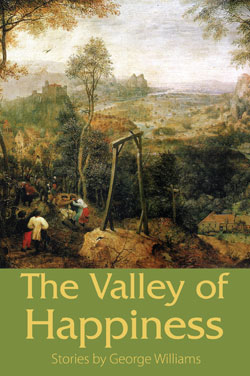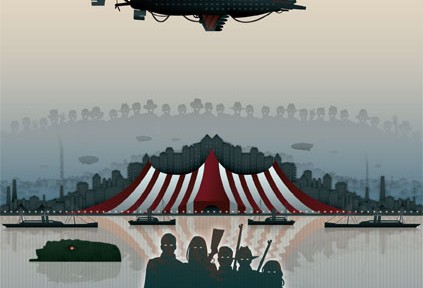Friends, I had the honor of doing this interview with George Williams, a short story writer and novelist who teaches at Savannah College of Art and Design.
Mr. Williams is a very interesting man who had the great fortune to work with Donald Barthelme, whose writing marginally resembles the stories in The Valley of Happiness. If you don’t know Mr. Barthelme’s work, why not pick up one of the man’s books? Failing that, it looks as though a kind Internet citizen has secured permission to collect some works online. (Cool…look at one of Mr. Barthelme’s syllabi!)
(A slight tangent: one of the things in life for which I’m most grateful is that I can say that I worked with some all-time great writers and teachers: Ira Sukrungruang, Robert O’Connor, Lee K. Abbott, Lee Martin, Erin McGraw, Kathy Fagan, Michelle Herman… Writers and scholars are all part of a line of knowledge seekers that goes all the way back to Socrates and beyond. Mr. Williams is in Mr. Barthelme’s line. I know folks who are in Raymond Carver’s line. We should all take a moment to reflect upon how thankful we are for the teachers we’ve had along the way.)
One of the stories in Valley is titled “Televangelist at the Texas Motel.” The story is a single page; three paragraphs of relentless sentences and exclamation points. When I read the story, I made the note that the piece is “a kind of prayer.” During the course of our conversation, Mr. Williams pointed out that “Televangelist” began life as an exercise assigned by Mr. Barthelme, who told his students to write a rant.
Remember, friends, no word we write is ever a waste. Even when our lines are flabby and our characters flat, we’re building our skills and increasing the likelihood that the next piece will be better. In many cases, including this one, exercises can even be published. This story appeared in Gulf Coast in 1989.
Mr. Williams has published two collections, both with Raw Dog Screaming Press. Both volumes also feature jacket art created by great artists who also happen to work for free, seeing as how they’ve been dead for hundreds of years. The tone of The Valley of Happiness and its stories is set by “The Magpie on the Gallows,” a painting by Pieter Bruegel the Elder.
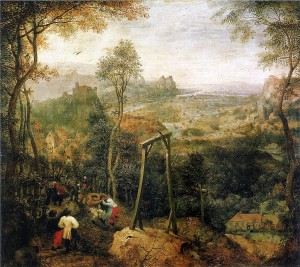
Mr. Williams admires the feeling of the painting. At first, you think that one of the men is being led to the gallows for a hanging. Then you realize that there is simply a party happening…in the same place where those folks witness executions.
For this exercise, I’m pretend-assigning you in Barthelme style to compose a rant based upon a classic (public domain) painting. What are some of the qualities of a rant?
- Extreme emotion. Rants are what happen when our reasonable rhetoric has been ignored.
- Brazen language. Subtlety doesn’t quite work for a rant.
- A subject worthy of the above. Did the drive-through worker forget to give you a third napkin? You’ll live. Confront a subject of real importance to the individual or the larger world.
Here are some examples. Feel free to download the images so you can see bigger versions.
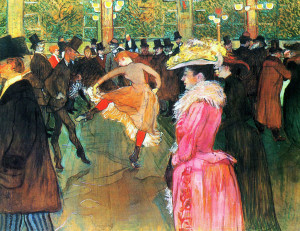
Henri de Toulouse-Lautrec’s “At the Moulin Rouge, The Dance”
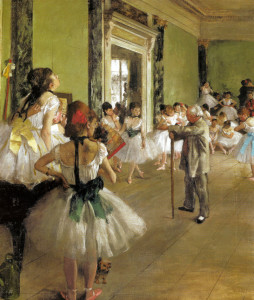
Edgar Degas’ “The Dance Class”
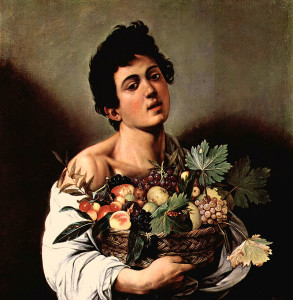
Caravaggio’s “Boy With a Basket of Fruit”
There’s plenty to rant about in these paintings. Are you pleased or angry that the all-male space seems to have been turned into a co-ed gathering? Can you believe what the ballerina with the green bow said about the one with the yellow bow? They’re supposed to be friends! And can you believe the lengths to which dieticians will go to try and make you add more fruits to your diet?!?!?
Those paintings don’t do anything for you? That’s fine. There are plenty more paintings where those came from. You can find 44,000 paintings here.
Want an example of an audio rant? Here’s playwright/comedian Lewis Black laying down some truth:
Good luck writing your own rants. You never know; you might produce a publishable piece of work! And keep in mind that you could always paste the result of your labor into a comment on this page. Who knows? Maybe I’ll publish your rant on its own page and write about what we can learn from you!
Exercises
Donald Barthelme, George Williams, Raw Dog Screaming
Show Notes:
Enjoy this interview with George Williams, author of The Valley of Happiness, a collection published by the fine people at Raw Dog Screaming Press.
Take a look at Mr. Williams’s Goodreads page:
https://www.goodreads.com/author/show/4875077.George_Williams
Order your copies of his Raw Dog Screaming books from the publisher:
http://rawdogscreaming.com/authors/george-williams/
Here is a text interview Mr. Williams granted to D. Harlan Williams:
http://www.dharlanwilson.com/dreampeople/issue35/interviewwilliams.html
Mr. Williams refers to a book about the Shakespeare Authorship question. He’s talking about James Shapiro’s excellent book, Contested Will:
http://www.theguardian.com/books/2010/mar/20/contested-will-who-wrote-shakespeare
Here’s “The Magpie on the Gallows,” the painting that Mr. Williams chose for the cover of his collection:

Like writing exercises? Here is one inspired by the conversation I had with Mr. Williams:
http://www.greatwriterssteal.com/2015/01/02/an-exercise-inspired-by-george-williams-author-of-the-valley-of-happiness/
Visit my website: http://www.greatwriterssteal.com
Like me on Facebook: https://www.facebook.com/GreatWritersSteal
Follow me on Twitter: @GreatWritersSte
Music: “BugaBlue,” Live At Blues Alley by U.S. Army Blues is licensed under a Public Domain Mark 1.0 License.
http://freemusicarchive.org/music/US_Army_Blues/Live_At_Blues_Alley/
Many thanks to the Library of Congress for their beautiful public domain images:
http://www.loc.gov/pictures/item/2012649048/ (Savannah during the Civil War era!)
http://www.loc.gov/pictures/item/fsa1998006340/PP/ (Voters in 1940 North Carolina waiting to cast their ballots!)
Short Story Collection
2014, George Williams, Raw Dog Screaming
Title of Work and its Form: “The Road to Damascus,” short story
Author: George Williams
Date of Work: 1993
Where the Work Can Be Found: The piece first appeared in the Summer/Fall 1993 issue of Gulf Coast, one of the most respected journals around. The story was awarded a Pushcart Prize and was included in the 1994/1995 anthology. Raw Dog Screaming Press published Gardens of Earthly Delight in 2011; the book collected some of Mr. Williams’s work, including “The Road to Damascus.” Why not purchase the book directly from the small press? The RDSP folks and Mr. Williams would also be pretty stoked, I’m sure, if you purchased the book or the reasonably priced Kindle version from Amazon.
Bonuses: Here is an interview Mr. Williams did with D. Harlan Wilson for Issue 35 of The Dream People. Here is an interesting review of Garden by I Read Odd Books. Here is an interview in which Mr. Williams discusses his writing process with Heidi Ruby Miller.
Element of Craft We’re Stealing: The Writer/Reader Relationship
Discussion:
This fairly short short story is an intense second-person examination of a man who is losing control. It begins in relative calm; he/you “are carving a roasting chicken” and you are convincing yourself that “the knife will not-I repeat-not of its own free will stab your lovely wife clean through the back.” You’re an insurance salesman and you fantasize about shouting racially provocative statements in the office. By the end of the story, of course, the “you will not’s” increase in magnitude, climaxing as “God in his thunder is readying to avenge right now, for the summer thunderhead swept in off the Gulf, it says, and you can hear it say, BLOWOUT SALE ENDS SATURDAY. PREPARE TO DIE.”
None of us should be surprised that this piece is as short as it is. The language and ideas are pretty hardcore; that kind of intensity can wear a reader down if it goes on for hundreds of pages. But a handful of pages? It’s not a problem at all. The writer’s responsibility, therefore, is to make the language in the piece as potent as possible. Here’s one way in which Mr. Williams turns up the heat: by structuring his sentences in an unanticipated manner. Look at the first sentence of the second paragraph:
You will not at your boss’s annual summer evening Hawaiian pool party walk up to your associate’s wife and pluck the nursing newborn from her disbelieving arms and dash it on the mossy stones of the Japanese rock garden.
Most of the time, the location of the hypothetical events would go AFTER “you” and “the wife” like so:
You will not walk up to your associate’s wife at your boss’s annual summer evening Hawaiian pool party and pluck the nursing newborn…
What’s the effect of casting the sentence in the way Mr. Williams did? The reader is slightly disoriented. This kind of feeling is appropriate and even welcome in a very short piece in which “you” are being asked to address “your” desire to do some very bad things. “Normal” stories should run by the rules of the “normal” world. Mr. Williams’s story takes place in the mind of someone who is a little bit “abnormal,” so it stands to reason that the way he puts his thoughts together would also be a little “abnormal.”
A writer has a very special relationship with his or her readers. No matter the kind of story, the first sentences are a kind of introduction between two people. In the “real” world, a relationship is established very quickly with verbal and non-verbal cues. Say you go to the DMV. You smile a little bit at the person behind the counter and they smile back. You hold out a handful of documents, greet the employee and tell him or her what you want. In the space of only a few seconds, you and the DMV employee tell each other that you’re both pleasant and cool people and that you both are happy to address your mutual goals. (You want to get your licensed renewed and the employee wants to get you out the door so they can help the next person.)
Here’s the beginning of Hardy’s Tess of the D’Urbervilles:
Phase the First: The Maiden, I-XI
I
On an evening in the latter part of May a middle-aged man was walking homeward from Shaston to the village of Marlott, in the adjoining Vale of Blakemore, or Blackmoor. The pair of legs that carried him were rickety, and there was a bias in his gait which inclined him somewhat to the left of a straight line. He occasionally gave a smart nod, as if in confirmation of some opinion, though he was not thinking of anything in particular. An empty egg-basket was slung upon his arm, the nap of his hat was ruffled, a patch being quite worn away at its brim where his thumb came in taking it off. Presently he was met by an elderly parson astride on a gray mare, who, as he rode, hummed a wandering tune.
How is Hardy greeting you? Well, I would say that he is checking to make sure you have a cup of tea before telling you a long, but interesting story. He doesn’t begin with Tess. No, he orients you in the world of his story and begins establishing the big-hearted, but run-down and imperfect world that Tess calls home. You are a traveler walking along Hardy.
Compare that to the opening of “The Road to Damascus:”
You are carving a roasting chicken. The knife will not-I repeat-not of its own free will stab your lovely wife clean through the back. The chicken is food: it is not a dead bird, a derelict descendant of vanished dinosaurs spilling ammoniac rot and kidney slick onto the carving platter your in-laws from St. Petersburg mailed you two weeks before your wife five years ago was delivered prematurely of a stillborn girl while you were in a topless bar in Fort Lauderdale drunk out of your mind with colleagues.
Mr. Williams is pointing his finger at you (in a friendly way, of course) and slamming you into the mindset of a person who doesn’t resemble you in the least. Writers should like to play around and relate to readers in different ways from time to time.
What Should We Steal?
- Build intensity by employing oddly structured sentences. Calm, Strunk & White-approved sentences are great in some pieces, but inappropriate for others.
- Get in your reader’s face from time to time. A relationship involves all kinds of different interactions, and that includes the relationship between writer and reader.
Short Story
1993, Garden of Earthly Delights, George Williams, Gulf Coast, Raw Dog Screaming, The Writer/Reader Relationship
I’ve pointed out how fun and generous Matt is in my previous coverage of Odd Men Out. (In case you missed them, here are What We Can Steal From Odd Men Out and GWS Inside the Craft: Matt Betts.) Matt’s book is fun and engrossing and can be purchased at Raw Dog Screaming Press and Amazon.
In conducting the very first Great Writers Steal interview, I wanted to ask Matt about his craft and about his own literary borrowing habits. As you’ll see, his responses are both thoughtful and helpful to the rest of us.
NOTE: Please be aware that the interview may contain mild spoilers. I don’t think you’ll really be spoiled; Odd Men Out‘s blurbs make it clear which baddies the good guys must fight. Further, it really shouldn’t be a shock that a novel-an adventure/science fiction/horror novel, no less-would have a climactic battle 80% of the way through. One sensitive spoiler is concealed with invisotext. Click and drag over the text if you want to see it.
 When did you begin writing and how important have the science fiction/horror communities been to you, both in terms of inspiration/stealing and in helping you improve your work?
When did you begin writing and how important have the science fiction/horror communities been to you, both in terms of inspiration/stealing and in helping you improve your work?
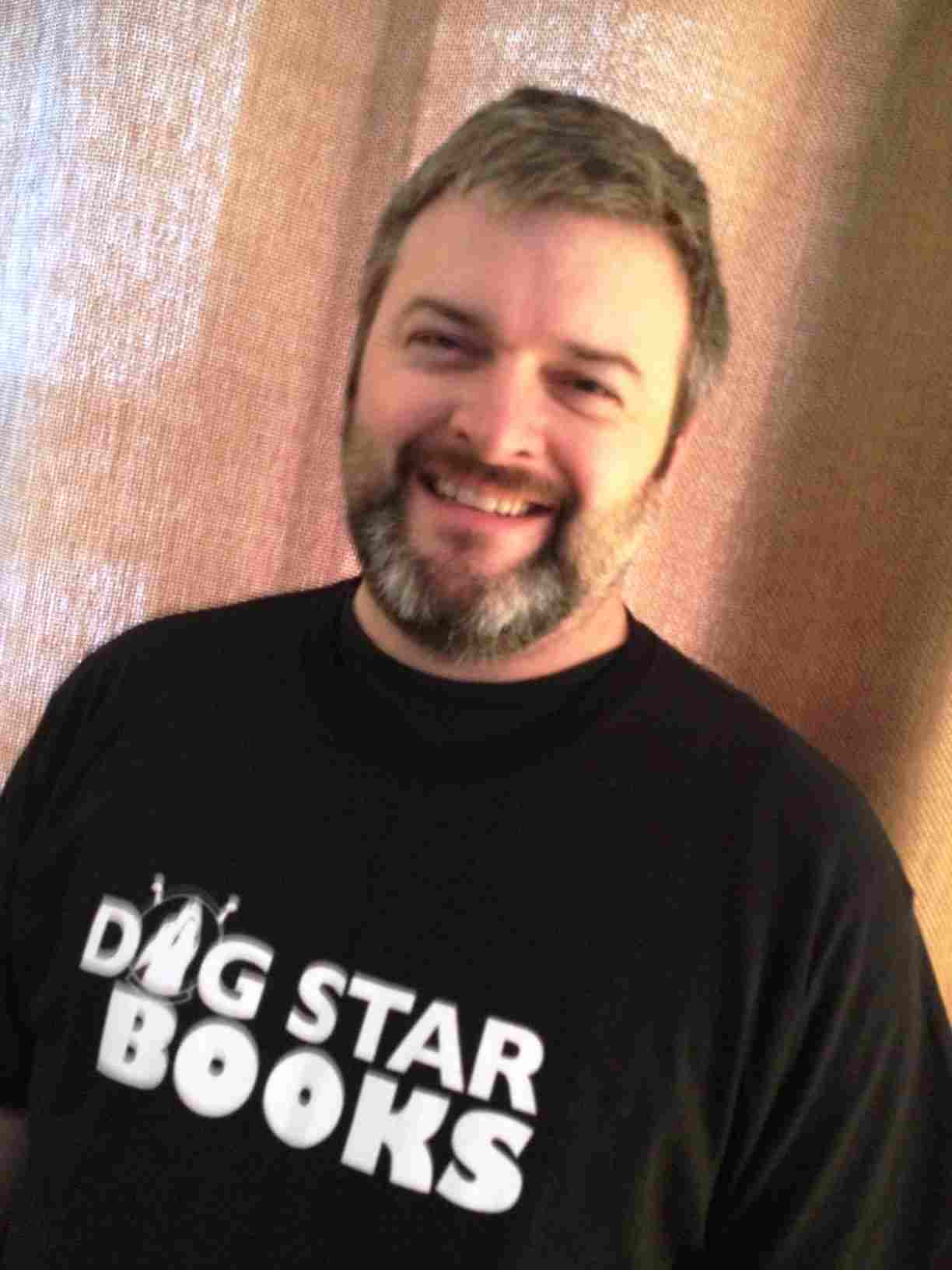 You know, I was writing in high school. And college, but I didn’t really get serious until the last ten years or so. In college, I had professors that were pretty much against anything genre, so I was very discouraged. I stopped writing for 5-6 years because of it.
You know, I was writing in high school. And college, but I didn’t really get serious until the last ten years or so. In college, I had professors that were pretty much against anything genre, so I was very discouraged. I stopped writing for 5-6 years because of it.
I’ve always been I to sci-fi and horror. But when I started working with writing groups here in Columbus [Ohio], I usually worked with non-genre writers. It kind of worked out that way. We all learned our crafts together.
I owe a lot to the horror and sci-fi I read, though. King was a big favorite, Anne Rice too. While I consider myself more of a sci-fi writer, I read a lot more horror.
I spent a lot of time in college, while my professors were telling me how terrible genre fiction was, reading a lot of horror and suspense anthologies and seeing how stories worked. How characters worked, etc. I still have one of those anthologiess in my collection.
 What are the qualities of genre writers that “literary” writers might most want to steal?
What are the qualities of genre writers that “literary” writers might most want to steal?
 I think both types of writers can learn from each other. And I think that’s why you see so many novels with a foot in each camp that climb the charts and do well with readers.
I think both types of writers can learn from each other. And I think that’s why you see so many novels with a foot in each camp that climb the charts and do well with readers.
The pacing of genre novels tends to be faster than literary. Usually. One of my favorites is Faulkner. My dad has always been a fan and it rubbed off on me.
 It’s interesting that you say that about pacing; in reading Odd Men Out, I was reminded of the short-chapter style of Alex Cross books, The Da Vinci Code and other “thriller” novels. Did you have any specific structural models for the book?
It’s interesting that you say that about pacing; in reading Odd Men Out, I was reminded of the short-chapter style of Alex Cross books, The Da Vinci Code and other “thriller” novels. Did you have any specific structural models for the book?  You know, I can’t say that I had particular structural models for the book as far as literary models. I did have that pace in mind from some of the old serial novels and serial movies. The idea that each chapter left the reader or viewer with a cliffhanger or minicliffhanger.
You know, I can’t say that I had particular structural models for the book as far as literary models. I did have that pace in mind from some of the old serial novels and serial movies. The idea that each chapter left the reader or viewer with a cliffhanger or minicliffhanger.
When I went back and did some of the re-editing, I looked at my chapters and tried to use the length of the chapters to my-and the story’s-advantage. I deliberately put some really short ones together and stuck some longer ones in the middle. I found it helped propel story forward better.
I hate to keep fawning over Elmore Leonard, but he works with varying lengths of chapters well. He certainly showed how it was possible to use that to the plot’s advantage.
 I did notice that the sections during the action setpieces were shorter, speeding the narrative up and allowing you to switch between the perspectives of characters who were in different places. To what extent were you influenced by these kinds of sequences in action and science fiction films?
I did notice that the sections during the action setpieces were shorter, speeding the narrative up and allowing you to switch between the perspectives of characters who were in different places. To what extent were you influenced by these kinds of sequences in action and science fiction films?
 Quite a bit. I think I’ve mentioned that I’ve been a pop culture junkie for a long time. I a huge fan of action movies - so much so that I claim Die Hard and Lethal Weapon as my two favorite Christmas movies. But watching well-made action and suspense movies really influenced me. I love when a director and a script can switch between the bad guy and the good guy effectively. An audience gets that look at what could happen, and can anticipate how the hero is going to get out of it.
Quite a bit. I think I’ve mentioned that I’ve been a pop culture junkie for a long time. I a huge fan of action movies - so much so that I claim Die Hard and Lethal Weapon as my two favorite Christmas movies. But watching well-made action and suspense movies really influenced me. I love when a director and a script can switch between the bad guy and the good guy effectively. An audience gets that look at what could happen, and can anticipate how the hero is going to get out of it.
Back in college, there was a video store (yes, actual video tapes) that had some ridiculous deal, like 5 movies for 5 dollars, but you could only have them for one night. My roommate and I would go there several times a week. At first we were renting all the good movies we heard about, but when those ran out, we started renting the bad ones. Eventually, we were renting movies just to find one good thing about them. A good line, a good chase, cinematography.
It was actually a good study in story. And characters. And plot. I really got to look at what made a movie tick.
 I love Die Hard and especially Lethal Weapon. What do you see as the advantages and disadvantages of casting your final battle with the dragon-literally in this case-in prose instead of celluloid?
I love Die Hard and especially Lethal Weapon. What do you see as the advantages and disadvantages of casting your final battle with the dragon-literally in this case-in prose instead of celluloid?  Ugh. I was starting to think it was a bad idea when I got to that. I actually wrote some of that scene early on, because I had had a specific part of the scene stuck in my head for a while. I wrote a few pages around that specific part, and then went back to writing parts earlier in the book. I would peck away at the dragon scene bit by bit. It was tough to choreograph. Everything and everyone in the book converged around that scene. So, I was working from different POVs and slightly different timelines, etc. It got so I dreaded going back to it. But I’d plucked away at it enough that by the time I got to it chronologically, the skeleton of the scene was there.
Ugh. I was starting to think it was a bad idea when I got to that. I actually wrote some of that scene early on, because I had had a specific part of the scene stuck in my head for a while. I wrote a few pages around that specific part, and then went back to writing parts earlier in the book. I would peck away at the dragon scene bit by bit. It was tough to choreograph. Everything and everyone in the book converged around that scene. So, I was working from different POVs and slightly different timelines, etc. It got so I dreaded going back to it. But I’d plucked away at it enough that by the time I got to it chronologically, the skeleton of the scene was there.
So, really, the disadvantage was having everything come to that. All of the good guys and bad guys, ancillary characters, they were pretty much all there. If one of the plotlines didn’t work, I was in trouble. I’m honestly not sure what the advantage to that situation was. Looking back, it seems like I just made more work for myself!
But I think it worked out, thankfully! I had so many versions before the final. It was really like choreographing a fight scene for the stage. I had a friend in college who did fight choreography and I was always fascinated by what went into making it look good. That’s kind of how I had to approach it here.
 Well, speaking of movie terminology[…spoiler…] did you intend the “device” to be a MacGuffin in the story? The device certainly figures into the climax of the book, but I was a little surprised that you used it in such a passive way.
Well, speaking of movie terminology[…spoiler…] did you intend the “device” to be a MacGuffin in the story? The device certainly figures into the climax of the book, but I was a little surprised that you used it in such a passive way.
 It really was.[…spoiler…] I really planned on it being something that actually carried on a bit more, maybe even into another novel, but in the end I really saw it as a MacGuffin that was going to bring everyone together for the rest of the story. I had vision of the glowing briefcase in Pulp Fiction as they were trying to open the device and figure it out. It was meant to be a means to an end for the Sons of Grant, and a reason to give chase for the others. The origins of the device also left open a wealth of other types of devices from Dr. Poley in the future.
It really was.[…spoiler…] I really planned on it being something that actually carried on a bit more, maybe even into another novel, but in the end I really saw it as a MacGuffin that was going to bring everyone together for the rest of the story. I had vision of the glowing briefcase in Pulp Fiction as they were trying to open the device and figure it out. It was meant to be a means to an end for the Sons of Grant, and a reason to give chase for the others. The origins of the device also left open a wealth of other types of devices from Dr. Poley in the future.
It also left the possibility that the device didn’t even work. Which could be explored in the future. I’m not saying it didn’t, but without the evidence, the OMO could well think it. There was this great scientist and he built a lot of fantasic things, but were they all reliable? I may explore that idea further. If not in a novel, maybe a short story. Of course, I didn’t mean to build a plot device that was thin or fulfilling. I wanted something just dangerous enough to be interesting and hopefully serve as a little bit more than something that just didn’t end up going boom, you know?
 Very interesting! I do wonder what other devices were created in the alternate United States. One of the challenges of alternate history, it seems to me, is clearly delineating the “break” with our reality and filling in the differences in the world of the narrative as opposed to ours. You definitely offer us glimpses of what happened to the President and how the fighting in the Civil War was suspended; what was your thinking in deciding how much to tell? I’m not sure you mention a concrete year for the story.
Very interesting! I do wonder what other devices were created in the alternate United States. One of the challenges of alternate history, it seems to me, is clearly delineating the “break” with our reality and filling in the differences in the world of the narrative as opposed to ours. You definitely offer us glimpses of what happened to the President and how the fighting in the Civil War was suspended; what was your thinking in deciding how much to tell? I’m not sure you mention a concrete year for the story.  I don’t come right out and name a year. That was a criticism of one of my early critiquers. So I went back and planted clues, but those weren’t even concrete. I was aiming for the early 1890s. I mention that the first battle of Gettysburg happened as normal, and then one with the chewers at Gettysburg. So, those hints, along with a few others, set the timeline for this. In the next book, I might start with a big stamp on the cover page that says 1895, or whatever I make it.
I don’t come right out and name a year. That was a criticism of one of my early critiquers. So I went back and planted clues, but those weren’t even concrete. I was aiming for the early 1890s. I mention that the first battle of Gettysburg happened as normal, and then one with the chewers at Gettysburg. So, those hints, along with a few others, set the timeline for this. In the next book, I might start with a big stamp on the cover page that says 1895, or whatever I make it.
It was interesting once I made that break with their technology. I found it fun to play with what actually happened and what I wanted to happen. I found myself accelerating the advances in weapons, which seemed logical considering they were facing the chewers, and decelerating their civilization, since it was being destroyed by the chewers.
 For whatever it’s worth, I didn’t mind not having a date. Cyrus and Bethy aren’t really thinking about the year or anything; they’re just dealing with the circumstances in which they find themselves. I got the point that we were in Reconstruction and things are very different. My two cents for fun. Maybe I benefited because I wasn’t thinking, “Gee, I wonder if Tilden and Hayes were in the 1876 election in this timeline.”
For whatever it’s worth, I didn’t mind not having a date. Cyrus and Bethy aren’t really thinking about the year or anything; they’re just dealing with the circumstances in which they find themselves. I got the point that we were in Reconstruction and things are very different. My two cents for fun. Maybe I benefited because I wasn’t thinking, “Gee, I wonder if Tilden and Hayes were in the 1876 election in this timeline.”
 Thanks! I actually enjoyed not setting it firmly in a certain date. It kept the story ambiguous for the reader. I saw the West as a pretty desolate wasteland when I started. I softened that a bit as I went, with more pockets of people than originally intended. I wondered at some point whether any of those pockets would agree on what year it was if they got together to talk about it. So, that’s another reason I left it in a general area.
Thanks! I actually enjoyed not setting it firmly in a certain date. It kept the story ambiguous for the reader. I saw the West as a pretty desolate wasteland when I started. I softened that a bit as I went, with more pockets of people than originally intended. I wondered at some point whether any of those pockets would agree on what year it was if they got together to talk about it. So, that’s another reason I left it in a general area.
 Finally, what do you hope that fellow writers will steal from you after they read Odd Men Out?
Finally, what do you hope that fellow writers will steal from you after they read Odd Men Out?
 Oh. What do I hope people will steal from me? That’s a good question. I learned/stole/lifted so many things from other writers. I hope that, in the long run, writers will write whatever they want and not hold anything back because it isn’t marketable or it doesn’t fit into a nice category. I wrote a story that I enjoyed, first and foremost, and it just happened to have sci-fi, steampunk, horror, alternate history, a Godzilla-like monster, zombies and maybe a few more things tossed in for good measure. But it was the story I wanted to tell. There were drafts where I thought of eliminating the zombies and others where I got rid of the lizards. In the end, it wasn’t satisfying to me, so I kept working on making it a better story. The right editor and publisher came along when I got it right. And with their help, we made it even better, I think.
Oh. What do I hope people will steal from me? That’s a good question. I learned/stole/lifted so many things from other writers. I hope that, in the long run, writers will write whatever they want and not hold anything back because it isn’t marketable or it doesn’t fit into a nice category. I wrote a story that I enjoyed, first and foremost, and it just happened to have sci-fi, steampunk, horror, alternate history, a Godzilla-like monster, zombies and maybe a few more things tossed in for good measure. But it was the story I wanted to tell. There were drafts where I thought of eliminating the zombies and others where I got rid of the lizards. In the end, it wasn’t satisfying to me, so I kept working on making it a better story. The right editor and publisher came along when I got it right. And with their help, we made it even better, I think.
I’m not sure that exactly answers your question. I love mash-ups and crazy mixes and I’d love to see more. And I’d like to see more authors following their muse.
Novel
GWS Interview, Matt Betts, Odd Men Out, Raw Dog Screaming
When I first e-mailed Matt to arrange the first GWS interview, I had no idea that he would be so generous with his time and his thoughts. Odd Men Out is a fun book-available now at Raw Dog Screaming Press and Amazon-and the book certainly seems like the kind of work that would emerge from a curious and engaging guy like Matt.
In the course of telling him what I might ask about during our interview, I hadn’t expected him to offer thoughtful and lengthy responses. I share them with you (with his permission, of course) to offer a look into the way Matt approaches his work and solves the problems that confront us all in some way.
Odd Men Out is an adventure/science fiction/horror/steampunk novel, and that means that Matt needed characters to fulfill certain dynamics in addition to seeming like real people. I mentioned that two of the characters seemed to have echoes of Han Solo and Luke Skywalker. (EVERY story that resembles Odd Men Out‘s narrative will have these resemblances, of course.) Here are Matt’s thoughts on creating dynamics between characters and making them his own.
Though, when you mention Cyrus and Lucy being Star Wars analogues, I can see where you get that, but it was never a thing I really thought about. I love Star Wars - it was one of the first movies I remember seeing in a theater, so it heavily influences me, but I never thought “here’s my Han Solo, here’s my Luke.” I love Firefly and Aliens and comic book teams like The Avengers and the X-Men. I started writing the book thinking of those great casts and ensembles and wanted to have one of my own. I wanted believable adventurers who legitimately had reasons not to trust each other and not to get along. So, as much as I love Star Wars, it really never entered my mind as I wrote Odd Men Out. There were so many steampunk, old west, alternate history things going on, that actual outer space-type science fiction really never came into the process…
…It was strange that I never considered the movie while writing Odd Men Out, or even when I was editing it. I can certainly see correlations in the functions of some of the characters now. But it was weird that it hadn’t come to me before that.
I think Matt is pointing out that we may have some explicit inspirations for our work, but there are always influences that we don’t think about consciously.
Matt’s book is set in an alternative United States in which the emergence of zombie-like creatures changes American priorities. (It was hard enough to fight the Civil War…can you imagine doing so with monsters in the mix?) Anyone who writes about zombies or vampires or werewolves or spaceships or aliens must set their own rules for how THEIR iterations fit in with all of the others. There are approximately eleventy trillion zombies in media right now; how did Matt approach creating his “chewers?”
You’re absolutely right about the idea of creating rules for the various ‘monsters’ and for the science in the book. I did kind of have to pick and choose whose mythology I wanted to follow and what I wanted to create of my own. Zombies are certainly weird, as they have become so popular. There are so many interpretations, that I found myself gravitating toward the more traditional versions, if such a thing exists. I looked more at the physiology of things like the original Night of the Living Dead, for the slow-moving, shambling monsters, rather than the running, screaming zombies we’ve seen in more recent films. The main reason was purely story-related. I needed my monsters relatively slow to give characters more of a fighting chance.
I started the novel long before The Walking Dead was on televison, and I never really cared for the graphic novels so much, so most of my zombie influence came from the movies like Night of the Living Dead and Dawn of the Dead. I remember watching some of those when I was in high school and having my eyes covered because they scared the crap out of me. Now, the book went through several rewrites, and by the time I was doing those, The Walking Dead was on TV and I was watching those first seasons and loving them. But to me, Odd Men Out wasn’t, in my mind, ever a zombie novel. I meant to treat them at a fact of life, something in the background. An early note I had was that they were ‘carpet’ in the landscape. I’m not sure what that would mean to a reader, but it was an important note to me.
Matt makes a very important point: in a way, the unique circumstances of your world shouldn’t be a big deal. The reader may get through the first few chapters and think, “Zombies! Oh my! I wonder what happened!” Cyrus and Lucinda and Tom and Cashe do not think that way about the ghouls in their midst. They’re really just part of the furniture, so to speak.
It’s a sad truth in adventure-type stories: characters must die. Even characters that you and your audience like. Too bad. Here is how Matt approached deciding who was going to die and when. (Don’t worry. No spoilers.)
You mentioned useful characters dying and that was kind of a big deal as was editing. I did some major edits and rewrites of the story along the way and there were more characters that died in one of the last versions before the final. In fact, there were actually more characters introduced in the early (Turtle) chapters that lived, but they were later cut to streamline the story. There were survivors that were around basically to make Cyrus and the reader remember what happened on the Turtle from time to time and really, it wasn’t necessary. But in that working draft, some other important characters didn’t live to see the last chapter. I wasn’t always thinking of a sequel to the book and who I needed to keep around for it, it was really just a balancing act to see who I could lose and still be happy with the ending. I didn’t want a senseless death, but I wanted the reader to be a little shocked by losing someone that they didn’t expect. I didn’t want the reader to be comfortable with thinking they knew what would happen. There was a “Hamlet” version of the ending where every other character died. It was fun, but ultimately unsatisfying to the story itself.
Well, not everyone has an eye on a sequel (I have low self-esteem), but I love how the prospect worked into Matt’s thought process. Writing is all about making choices; some characters die because the story requires them to do so and others bite the bullet because it’s a necessity to the writer.
And how do we streamline those choices? Editing. This is not my favorite thing to do, but here is how Matt approached tuning up Odd Men Out:
I don’t think I consciously took this from any particular movie or book, but I remember being surprised by certain deaths Elmore Leonard’s works.
Elmore Leonard has this credo about his writing, and in doing my edits, I tried to stick close to it. He says, “Try to leave out the part that readers tend to skip.” When I was editing, I had several readers mark up the manuscript, and whenever someone told me a section or paragraph was too flowery or too much exposition, I ended up cutting it 9 times out of 10. I think I actually cut a couple of small chapters that way. I definitely cut out a number of point of views that way. I think I have the story from 4 POV characters now. In early drafts, it was more like 6, maybe 7. It made the the book too busy and I combined some characters and eliminated others.
Another piece of writing advice I followed is the old admonition to “Kill your Darlings.” The idea being that you can’t be afraid to delete what you consider your best work, if it really isn’t helping your story. I sat with my finger hovering over the delete button for a long time on some of my favorite passages. It hurt like crazy to cut them, but it certainly made the story stronger. It absolutely applied to killing off some of the characters that I loved as well.
I also applied that advice in a somewhat warped way to my main character, Cyrus. I wrote a note in his file specifically saying “Wound your Darlings.” I put Cyrus through hell in this story. Things happen to him. Some are by choice and others just happen, but it became a sport to see what I could actually do to him in the novel.
See why I called Matt “thoughtful” and “generous?” As I’ve said a trillion times, there is no step-by-step checklist you can follow in order to improve your writing. Craft advice must percolate inside our brains; after enough time, you’ll be able to make use of the lessons you didn’t know you were learning. What do you think of Matt’s experience and process? How does reading about his thoughts on craft affect your own?
Novel
2013, GWS Inside the Craft, Matt Betts, Odd Men Out, Raw Dog Screaming
Title of Work and its Form: Odd Men Out, novel
Author: Matt Betts (on Twitter @Betts_Matt)
Date of Work: 2013
Where the Work Can Be Found: The book can be purchased from Raw Dog Screaming Press. You may also want to purchase the book on Amazon. (The e-book is VERY reasonably priced as of this writing!) Check out the cool jacket art by Brad Sharp:
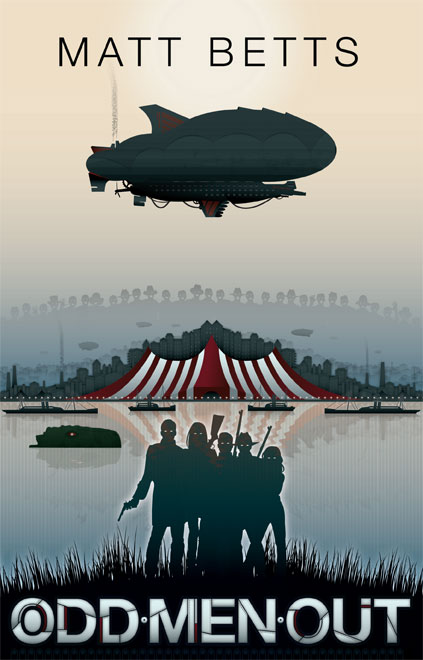 Bonuses: Here is the Goodreads page for Odd Men Out. Here‘s a brief but favorable review of Odd Men Out from Publisher’s Weekly. Here‘s a brief biography of Mr. Betts.
Bonuses: Here is the Goodreads page for Odd Men Out. Here‘s a brief but favorable review of Odd Men Out from Publisher’s Weekly. Here‘s a brief biography of Mr. Betts.
Element of Craft We’re Stealing: Narrative Momentum
Discussion:
What a fun book! Odd Men Out takes place during Reconstruction-but not in the history we remember from high school. Cyrus Joseph Spencer and the crew members of his “Turtle” (a five-story, six-legged machine that ferries people where they want to go) inhabit an America that has developed steampunk technology. And in which giant lizards are a threat. And in which a precarious truce replaced the open warfare of the Civil War. Oh, and don’t forget the “chewers,” humans who have succumbed to a virus that transforms people into zombies. Matt asserts that he’s a pop culture junkie, and that’s a great way to think about the book. Odd Men Out is a slam-bang adventure story that has all of the excitement and twists of a summer blockbuster. There are a few narrative threads in the book. Cyrus and Lucinda deal early on with the loss of their Turtle and join up with Cashe and the crew of the United Nations of America ship Leonidas Polk. All the while, Tom Preston, member of the Sons of Grant, takes advantage of his employer, entertainment impresario Umberto Cantolione. The book’s plot hums along quickly and the characters’ lives converge, as you might imagine, on a big, awesome battle that determines the fates of everyone involved.
As I pointed out, Matt really keeps the plot chugging along. The book consists of 91 chapters of varying lengths. Each section is anchored by the third person narrator, taking the perspective of each section’s focal character. During the climactic final battle, the sections are very short. The chapters are, by contrast, much longer during some of the quieter scenes between the high points. When I read the book, I was reminded of the kind of structure that is employed in books such as The Da Vinci Code or (to a lesser extent) The Firm. When the chapters are relatively short, the reader has less time to get bogged down in the narrative. The BIGGER ISSUES of the book are often stuck more firmly in your mind. For example, when you read The Firm, you can’t help but wonder: Will Mitch McDeere enjoy his life at the firm? What happened with those other lawyers who died? Oh no! I can tell something is wrong with this firm; what will Mitch do? Varying the lengths of your chapters is one of the ways in which you can shape how your reader digests your work and direct their understanding of it.
Matt had a TON of exposition that he needed to release in the book. After all, he was working in a world that was very much of his own creation. (The characters in The Firm, after all, were running around a world similar to ours, right?) The narrator does some “telling” in the book, but Matt also came up with fun ways to fill in the gaps. At one point, the slimy Tom Preston finds a notebook/diary that was kept by people who were witnesses to some of the “fun” and “crazy” events that occurred when the Odd Men Out world diverged from real history. Matt’s characters simply can’t know a lot of that information, so I enjoyed that he found a way to get it into the book.
As I mentioned, the book contains Matt’s take on zombies. I don’t know how he approached naming the creatures, but I could tell from the prose that he was very careful not to use the same word to describe the antagonists. So instead of writing “chewers” a thousand times, he sprinkled in words such as, “undead,” “the dead,” “ghoul” and “attacker.”
This principle is particularly prominent in sportswriting and with play-by-play announcers. How often can you say that Miguel Cabrera “hit” the ball? Instead, here’s what Miguel Cabrera does to the ball:
- wallops
- crushes
- knocks
- pounds
- taps
- slams
- ticks
- slaps
- rockets
- loops
- bunts
- powers
- jacks
- fouls
Each of these words kinda mean the same thing, but offer some very important distinctions. Be on the lookout for synonyms that you can use to add characterization and intensity, as well as to describe.
Above all, Odd Men Out is FUN. Isn’t fun one of the reasons we get into writing in the first place? “Genre” isn’t necessarily a bad word, either. Let’s consider a list of writers who have written in genres that are sometimes frowned upon:
- Kurt Vonnegut (science fiction)
- Shirley Jackson (horror)
- Stephen King (horror, fantasy, science fiction)
- Ray Bradbury (horror, science fiction)
- Harlan Ellison (science fiction)
- Ursula K. Le Guin (science fiction)
- Jane Austen (romance, steampunk, horror)
Can anyone honestly say that these writers are somehow lesser because they do literary work that can sometimes be considered “genre?”
What Should We Steal?
- Vary the lengths of your chapters. Action and suspense stories can benefit from a structure that boasts many small chapters.
- Experiment with a number of different ways to release exposition. Perhaps your character keeps a journal. Maybe there’s a crucial photograph in your piece that establishes an important plot point.
- Brainstorm synonyms for some of the words in your work that could be overused. Not only do you avoid boring people, but you force yourself to use words that are more powerful and descriptive.
- Have fun and don’t be afraid of the “g-word.” Just because a story features spaceships, zombies or long-lost loves doesn’t necessarily mean that a work isn’t “good” or “literary.”
Novel
2013, Alternate History, GWS Interview, Matt Betts, Narrative Momentum, Raw Dog Screaming
